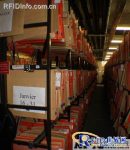
Bassin de Thau Hospital in France uses UHF RFID to track medical records
[ad_1]
Bassin de Thau Hospital in France has long adopted EPC Gen2 passive RFID tags and handheld readers to track medical records. In the near future, the information department of the hospital plans to upgrade its RFID solution and install fixed-channel type reading and writing equipment. After the fixed reading and writing equipment is installed, the efficiency of medical record tracking is further improved.
The installation of this RFID tracking solution saves labor and greatly improves work efficiency. Using a fixed read-write device to automatically read the tag ID, and a handheld reader to search for a specific location, the search time for medical records has been shortened from half a day to a few minutes.

There are about 40,000 medical records in the central archives of the hospital with Tageos RFID tags attached.
The solution is provided by system integrator Frequentiel and file management company Lamap. The solution uses Tageos EOS-500 passive UHF tags, Motorola Workabout Pro handheld readers, Deister UDL5 desktop RFID readers and Frequentiel middleware, which is used to parse RFID data and send it to the background data recording software . Initially, the label attaching work was provided by Lamap. Currently, hospital employees attach Tageos RFID tags on their own.
The hospital has a total of 823 beds, and all medical records are stored in the central archives. Normally, the hospital processes about 50-85 medical records every day. Before the RFID system was adopted, barcodes were required to be scanned before the medical records were transferred to other colleagues and when the medical records were returned to the archives.

Folder where tageos RFID tags are pasted
If the medical records are not put back in the archives room in time, employees need to search through tens of thousands of folders, and sometimes they need to phone to track down the whereabouts of the files.
With the RFID system in place, the efficiency of medical record archiving is greatly improved, and the phenomenon of loss of medical records is greatly reduced. First, the medical record management department sticks Tageos UHF RFID tags to each medical record. After the label is pasted, the desktop RFID reader reads the label code and sends the data to the background data recording software to be associated with the information and data of the specific patient.
To view the medical record, the doctor needs to take it out from the file management room and put it in the medical record cart as shown in the figure below. Then use a handheld RFID reader to read the code of the medical record so that the system can record the loan status of the medical record. According to French law, the hospital does not record the information of the person viewing the medical record.
The newly generated medical records are placed in a folder pasted with EOS-500 RFID tags. Currently, more than one-third of medical records have Tageos RFID tags attached. The hospital expects to stick RFID tags on its 15,000 medical record folders every year.

At the end of 2014, Bassin de Thau Hospital plans to complete the installation of the Motorola FX7400 fixed RFID read-write channel. When the medical record vehicle passes through the read-write channel, the label code of the medical record in the vehicle is automatically read. In the future, hospitals may use RFID technology for asset tracking.
[ad_2]



